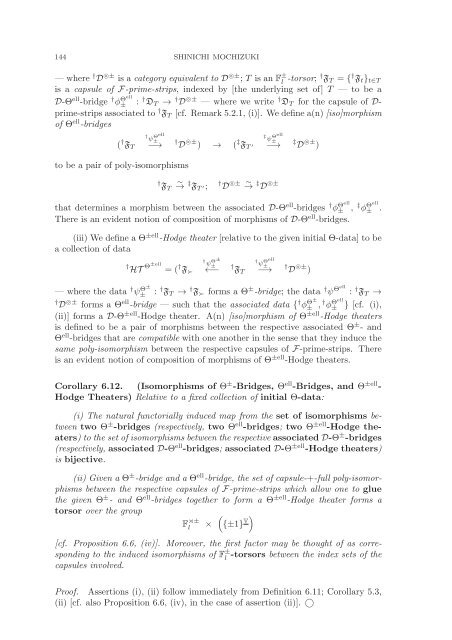Inter-universal Teichmuller Theory I: Construction of Hodge Theaters
Inter-universal Teichmuller Theory I: Construction of Hodge Theaters
Inter-universal Teichmuller Theory I: Construction of Hodge Theaters
You also want an ePaper? Increase the reach of your titles
YUMPU automatically turns print PDFs into web optimized ePapers that Google loves.
144 SHINICHI MOCHIZUKI<br />
—where † D ⊚± is a category equivalent to D ⊚± ; T is an F ± l -torsor; † F T = { † F t } t∈T<br />
is a capsule <strong>of</strong> F-prime-strips, indexed by [the underlying set <strong>of</strong>] T —tobea<br />
D-Θ ell -bridge † φ Θell<br />
± : † D T → † D ⊚± —wherewewrite † D T for the capsule <strong>of</strong> D-<br />
prime-strips associated to † F T [cf. Remark 5.2.1, (i)]. We define a(n) [iso]morphism<br />
<strong>of</strong> Θ ell -bridges<br />
( † † ψ Θell<br />
±<br />
F T −→ † D ⊚± ) → ( ‡ F T ′<br />
to be a pair <strong>of</strong> poly-isomorphisms<br />
‡ ψ Θell<br />
±<br />
−→ ‡ D ⊚± )<br />
† F T<br />
∼<br />
→ ‡ F T ′;<br />
† D ⊚± ∼<br />
→ ‡ D ⊚±<br />
that determines a morphism between the associated D-Θ ell -bridges † φ Θell<br />
± , ‡ φ Θell<br />
± .<br />
There is an evident notion <strong>of</strong> composition <strong>of</strong> morphisms <strong>of</strong> D-Θ ell -bridges.<br />
(iii) We define a Θ ±ell -<strong>Hodge</strong> theater [relative to the given initial Θ-data] to be<br />
a collection <strong>of</strong> data<br />
† HT Θ±ell =( † † ψ Θ±<br />
±<br />
F ≻ ←− † † ψ Θell<br />
±<br />
F T −→ † D ⊚± )<br />
— where the data † ψ± Θ± : † F T → † F ≻ forms a Θ ± -bridge; the data † ψ Θell : † F T →<br />
† D ⊚± forms a Θ ell -bridge — such that the associated data { † φ Θ±<br />
± , † φ Θell<br />
± } [cf. (i),<br />
(ii)] forms a D-Θ ±ell -<strong>Hodge</strong> theater. A(n) [iso]morphism <strong>of</strong> Θ ±ell -<strong>Hodge</strong> theaters<br />
is defined to be a pair <strong>of</strong> morphisms between the respective associated Θ ± -and<br />
Θ ell -bridges that are compatible with one another in the sense that they induce the<br />
same poly-isomorphism between the respective capsules <strong>of</strong> F-prime-strips. There<br />
is an evident notion <strong>of</strong> composition <strong>of</strong> morphisms <strong>of</strong> Θ ±ell -<strong>Hodge</strong> theaters.<br />
Corollary 6.12. (Isomorphisms <strong>of</strong> Θ ± -Bridges, Θ ell -Bridges, and Θ ±ell -<br />
<strong>Hodge</strong> <strong>Theaters</strong>) Relative to a fixed collection <strong>of</strong> initial Θ-data:<br />
(i) The natural functorially induced map from the set <strong>of</strong> isomorphisms between<br />
two Θ ± -bridges (respectively, two Θ ell -bridges; two Θ ±ell -<strong>Hodge</strong> theaters)<br />
to the set <strong>of</strong> isomorphisms between the respective associated D-Θ ± -bridges<br />
(respectively, associated D-Θ ell -bridges; associated D-Θ ±ell -<strong>Hodge</strong> theaters)<br />
is bijective.<br />
(ii) Given a Θ ± -bridge and a Θ ell -bridge, the set <strong>of</strong> capsule-+-full poly-isomorphisms<br />
between the respective capsules <strong>of</strong> F-prime-strips which allow one to glue<br />
the given Θ ± -andΘ ell -bridges together to form a Θ ±ell -<strong>Hodge</strong> theater forms a<br />
torsor over the group<br />
F ⋊±<br />
l<br />
×<br />
({±1} V)<br />
[cf. Proposition 6.6, (iv)]. Moreover, the first factor may be thought <strong>of</strong> as corresponding<br />
to the induced isomorphisms <strong>of</strong> F ± l<br />
-torsors between the index sets <strong>of</strong> the<br />
capsules involved.<br />
Pro<strong>of</strong>. Assertions (i), (ii) follow immediately from Definition 6.11; Corollary 5.3,<br />
(ii) [cf. also Proposition 6.6, (iv), in the case <strong>of</strong> assertion (ii)]. ○
















